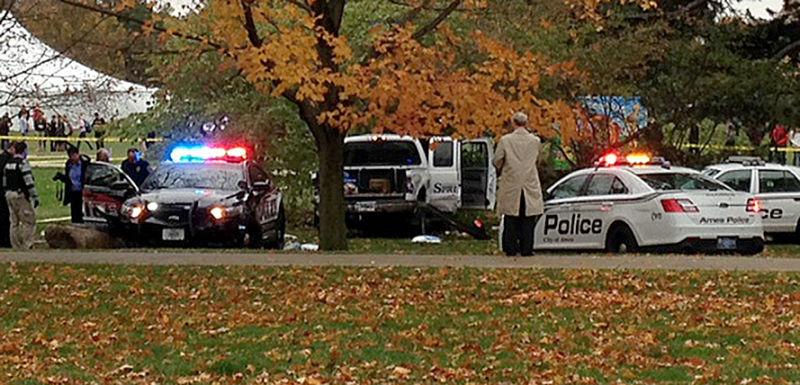Invstigation declares Officer Adam McPherson ‘acted reasonably’ in campus shooting
November 7, 2013
Story County attorney Stephen Holmes concluded that Ames Police Officer Adam McPherson “acted reasonably” and his “use of deadly force was justified,” after reviewing the investigation with the Division of Criminal Investigation.
“Upon reviewing the recording, interviews and video recordings of the event, Officer McPherson acted reasonably under very difficult circumstances,” said Mike Motsinger, Division of Criminal Investigation special agent in charge of the investigation.
McPherson continues to be on paid leave, which began Monday after the fatal car chase with Tyler Comstock, 19, of Boone, Iowa. The DCI in Iowa began investigating McPherson’s actions after he fired seven shots at Comstock’s vehicle, two of which struck Comstock resulting in his death.
“The suspect had every opportunity to comply with officers,” said Geoff Huff, public information officer for Ames Police. “At the end of the pursuit, the officers were out of options with two disabled squad cars and a suspect still intending to harm the officers and posing a very real and deadly risk to everyone in that area. Officer McPherson fired into the truck to stop the threat and stopped firing once it appeared the threat had been reduced.”
Comstock’s truck entered Central Campus, blowing through a Homecoming sign where he reversed across the grass into a wooded area. An Ames police car and ISU police car simultaneously rammed Comstock’s truck, pushing it into a tree. Comstock then accelerated and crashed into another tree, continuing to rev the engine until McPherson fired seven shots at Comstock’s vehicle.
DCI turned over the investigation to Holmes who discerned that McPherson’s actions were justified because Comstock “gave no sign to either officer that he was going to cease the car chase and end the threat he posed.”
Reasons Holmes gave for justifying McPherson’s actions included the fact that Comstock “could maneuver his vehicle as a dangerous weapon” at both responding and present officers. Comstock could also have made another “attempt to escape and again act in a reckless manner, placing members of the public at risk of death and serious injury.”
According to the Ames Police Department’s Pursuit of Motor Vehicles policy, “No more than one secondary unit shall become actively involved in a pursuit unless specifically directed otherwise by the on-duty shift supervisor; the involvement of more than two patrol vehicles may add to the hazards of the pursuit.”
Because of this policy, McPherson was under scrutiny when audio of the incident was released by news organizations. In the audio, a man who the audience assumed was a dispatch officer can be heard saying, “We know the suspect, so we can probably back it off.”
The voice on the audio was not a dispatch officer.
“The communication that was taking place was between the officers and the supervisors on the street,” Huff said. “At the point when the supervisor made the comment to back off the officer had already backed off and reduced speed. The reason they continued with lights and sirens was a warning to all the other bystanders.”
Huff said McPherson did follow protocol in the incident, backing off when it was suggested. Huff said McPherson continued to follow the vehicle because Comstock showed no signs of slowing down.
“We do believe the dash cameras speak for themselves,” Huff said.
At the news conference Thursday morning, the video from McPherson’s dash camera was played, showing the chase with Comstock’s truck through Ames and onto Central Campus.
In the video, McPherson fired seven shots rapidly at Comstock’s truck while Comstock continued to rev the truck’s engine.
“Officer McPherson fired into the truck to stop the threat, and stopped firing when the threat was reduced,” Huff said.
Holmes said Ames officers were faced with “an impossible situation” which began with Comstock’s first assault on police when he tried to back his trailer onto the hood of a police car, at which point officers could not disengage due to the posed threat.
Holmes said neither officer overreacted at the second confrontation point when Comstock spins his truck and is nose to nose with McPherson’s vehicle.
Holmes also said it is only at the third confrontation point when officers again try to disable Comstock’s vehicle by ramming into it that officers appropriately draw their weapons, fearing that Comstock will continue his “rampage.”
“It becomes a very precarious exercise to attempt to pick apart split second decisions. Much deference has to be given when questioning an officer’s presence of mind and judgment in a life threatening situation,” Holmes said.
According to Holmes, the investigation of the incident is complete. The only investigation that may continue is an internal investigation Ames police may begin within their own department.
Holmes also said that the investigation, which would normally take weeks to complete, was accelerated because of the controversy that was aggravated when the audio of the incident was released. Holmes said that may have lead the public to misconstrue all of the actual events.
Comstock’s parents were not available for comment and did not respond to phone calls.
Check back with the Daily as more details emerge.

















